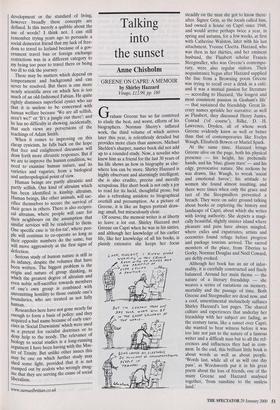Talking into the sunset
Anne Chisholm
GREENE ON CAPRI: A MEMOIR by Shirley Hazzard Virago, £12.99, pp. 160 Graham Greene has so far contrived to elude the best, and worst, efforts of his biographers. Norman Sherry's inflated work, the third volume of which arrives later this year, is relentlessly detailed but provides more clues than answers. Michael Shelden's sharper, nastier book did not add up to a rounded study. Now, a novelist who knew him as a friend for the last 30 years of his life shows us how in biography as else- where less can be more. Shirley Hazzard is highly observant and alarmingly intelligent; she is also erudite, precise and morally scrupulous. Her short book is not only a joy to read for its lucid, thoughtful prose, but also a refreshing antidote to biographical overkill and presumption. As a picture of Greene, it is like an Ingres portrait draw- ing: small, but miraculously clear.
Of course, the memoir writer is at liberty to leave a lot out. Shirley Ha77ard met Greene on Capri when he was in his sixties, and although her knowledge of his earlier life, like her knowledge of all his books, is plainly extensive she keeps her focus steadily on the man she got to know there- after. Signor Grin, as the locals called him, had owned a house on Capri since 1948, and would arrive perhaps twice a year, in spring and autumn, for a few weeks, at first with Catherine Walston, later with his last attachment, Yvonne Cloetta. Hazzard, who was then in her thirties, and her eminent husband, the Flaubert scholar Francis Steegmuller, who was Greene's contempo- rary, were also regular visitors. Their acquaintance began after Hazzard supplied the line from a Browning poem Greene was trying to recall over a drink in a café; and it was a mutual passion for literature — according to Ha 7zard, 'the longest and most consistent passion in Graham's life' — that sustained the friendship. Great lit- erary names sprinkle her narrative: as well as Flaubert, they discussed Henry James, Conrad ('of course'), Rilke, D. H. Lawrence, Dryden, all of whose work Greene evidently knew as well or better than that of contemporaries like Evelyn Waugh, Elizabeth Bowen or Muriel Spark. At the same time, Hazzard brings Greene alive on the page, both his physical presence — his height, his prehensile hands, and his 'blue, glassy stare' — and his edgy, provocative nature. She reckons he was drawn, like Waugh, to wreak 'social and emotional havoc'; his attitude to women she found almost insulting, and there were times when only the grace and tact of the Steegmullers prevented a breach. They were on safer ground talking about books or exploring the history and landscape of Capri, about which she writes with loving authority. She depicts a magi- cally beautiful, slightly sinister island where pleasure and pain have always mingled, where exiles and expatriates, artists and eccentrics found refuge before progress and package tourism arrived. The sacred monsters of the place, from Tiberius to Gorky, Norman Douglas and Noel Coward, are deftly evoked.
Although her book has an air of infor- mality, it is carefully constructed and finely • balanced. Around her main theme — the nature of a literary friendship — she weaves a series of variations on memory, mortality and the passage of time. Both Greene and Steegmuller are dead now, and a cool, unsentimental melancholy suffuses Shirley Hazzard's last pages. The shared culture and experiences that underlay her friendship with her subject are fading, as the century turns, like a sunset over Capri; she wanted to bear witness before it was too late not just to the nature of a famous writer and a difficult man but to all the ref- erences and influences they had in com- mon. In the end, this brilliant little book is about words as well as about people. 'Words last, while all of us will one day pass', as Wordsworth put it in his great poem about the loss of friends, one of the many Greene and Hazzard analysed together, 'from sunshine to the sunless land.'


















































































 Previous page
Previous page